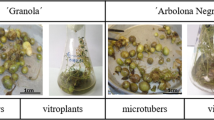Summary
Inoculating the roots of potato cvs Ostara, Laila, Kerrs Pink, and Pimpernel withCorynebacterium sepedonicum caused severe rotting of tubers and between 12 and 51 % decrease in yield. There was a significant cultivar/infection interaction. The numbers of tubers decreased significantly except for cv. Laila, which also showed little rotting of tubers, and the average tuber weight decreased most in cv. Pimpernel. The concentration ofC. sepedonicum was high in most inoculated tubers including those not showing symptoms.
Zusammenfassung
Wurzeln von gekeimten Saatknollen der Sorten Ostara, Laila, Kerrs Pink und Pimpernel wurden durch Tauchen in Suspensionen vonCorynebacterium sepedonicum inokuliert. Dies erbrachte einen beträchtlichen und signifikanten Ertragsrückgang, vor allem bei der Sorte Pimpernel (Tabelle 1); desweiteren zeigte sich eine signifikante Sorte/Infektion-Wechselwirkung. Inokulation ergab, mit Ausnahme von Laila, eine signifikante Senkung der durchschnittlichen Knollenzahl (Tabelle 2); am grössten war der Rückgang bei Kerrs Pink, während das durchschnittliche Knollengewicht am meisten zurückging bei Pimpernel (Tabelle 3). Der Ertragsrückgang bei Laila erfolgte durch Reduktion des durchschnittlichen Knollengewichtes, bei den anderen Sorten jedoch durch Rückgang der durchschnittlichen Knollenzahl. Diese Beobachtung lässt darauf schliessen dass die Entwicklung der Infektion bei Laila nach der Knollen-Initiierung einsetzte, während sie bei den anderen Sorten schon früher einsetzte und somit die Knollenzahl beeinflusste.
Im Gegensatz zu den anderen Sorten zeigten einige Tochterknollen von Laila äussere Symptome, in Verbindung mit starker Fäule, während in der Entwicklung interner Symptome nur geringe Unterschiede zwischen den Sorten gefunden wurden (Tabelle 4). Dennoch waren die Konzentrationen vonC. sepedonicum in den meisten symptomlosen Tochterknollen inokulierter Pflanzen hoch (Tabelle 4).
Die Ergebnisse zeigen dass die Sorte Laila gegen eineC. sepedonicum-Infektion resistenter als die anderen geprüften Sorten ist, dass jedoch hohe Konzentrationen des Erregers in symptomlosen Knollen von inokulierten Pflanzen gegen eine Verwendung bei der Züchtung sprechen.
Résumé
Des racines de tubercules de semence germés (variétés Ostara, Laila, Kerrs Pink et Pimpernel) sont inoculées par immersion dans des suspensions deCorynebacterium sepedonicum. Cela provoque une diminution conéquente et significative du rendement, en particulier pour la variété Pimpernel (tableau 1), et il existe une interaction significative variété/infection. L'inoculation diminue significativement le nombre moyen de tubercules (tableau 2) sauf pour la variété Laila; la diminution est la plus importante pour la variété Kerrs Pink, tandis que le poids moyen de tubercules diminue le plus pour la variété Pimpernel (tableau 3). La diminution du rendement pour la variété Laila est provoquée par une réduction du poids de tubercules. Cette observation suggère que le développement de l'infection pour la variété Laila débute après l'initiation de tubérisation, alors que pour les autres variétés, elle commence plus tôt et de ce fait influence le nombre de tubercules.
Peu de tubercules fils de la variété Laila montrent des symptômes externes associés à une pourriture importante en comparaison avec les autres variétés, alors que de petites différences s'observent entre toutes les variétés au niveau du développement de symptômes internes (tableau 4). Les concentrations deC. sepedonicum sont cependant élevées dans la plupart des tubercules fils ne présentant pas de symptômes et provenant de plantes inoculées (tableau 4).
Les résultats montrent que la variété Laila est plus résistante à l'infection deC. sepedonicum que les autres variétés testées, mais les fortes concentrations du pathogène dans les tubercules sans symptôme provenant de plantes inoculées empêchent son utilisation en multiplication.
Similar content being viewed by others
References
Anonymous, 1957. How can we interpret the zero tolerance and bacterial ring rot in certified seed potatoes. Report of the Seed Certification Committee of the Potato Association of America.American Potato Journal 34: 142–148.
Bohlool, B. B. & E. L. Schmidt, 1968. Nonspecific staining: its control in immunofluorescence examination of soil.Science 162: 1012–1014.
Bonde, R. & M. Covell, 1949. Effect of host variety and other factors on pathogenicity of potato ring-rot bacteria.Phytopathology 40: 161–172.
Bonde, R., F.J. Stevenson, C.F. Clark & R. V. Akeley, 1942. Resistance of certain potato varieties and seedling progenies to ring rot.Phytopathology 32: 813–819.
Bonde, R., F. J. Stevenson & R. V. Akeley, 1947. Breeding potatoes for resistance to ring rot.Phytopathology 37: 539–555.
Cherry, William B., 1970. Fluorescent-antibody techniques. In: J. E. Blair et al. (Eds), Manual of Clinical Microbiology. American Society for Microbiology. p. 693–704.
Dowson, W. J., 1957. Plant diseases due to bacteria. Cambridge. 232 pp.
Lelliott, R. A. & P. W. Sellar, 1976. The detection of latent ring rot (Corynebacterium sepedonicum (Speik. et Kotth.) Skapt. et Burkh.) in potato stocks.EPPO Bulletin 6,(2): 101–106.
Nelson, G. A., 1982.Corynebacterium sepedonicum in potato: Effects of inoculum concentration on ring rot symptoms and latent infection.Canadian Journal of Plant Pathology 4: 129–133.
Nelson, G. A. & R. J. Howard, 1982. Effect of the ring rot pathogen and latent potato viruses on ring rot symptoms and yield of potatoes.American Potato Journal 59: 213–219.
Nelson, G. A. & W. E. Torfason, 1974. Associative effects of leaf roll and ring rot on disease expression and yield of potatoes.American Potato Journal 51: 12–15.
Slack, S. A., A. Kelman & J. B. Perry, 1979. Comparison of three serodiagnostic assays for detection ofCorynebacterium sepedonicum.Phytopathology 69: 186–189.
Author information
Authors and Affiliations
Rights and permissions
About this article
Cite this article
Sletten, A. The effect ofCorynebacterium sepedonicum on symptoms and yield of four potato cultivars. Potato Res 28, 27–33 (1985). https://doi.org/10.1007/BF02357567
Accepted:
Issue Date:
DOI: https://doi.org/10.1007/BF02357567




